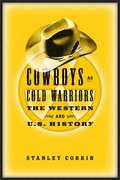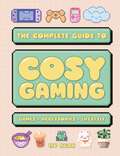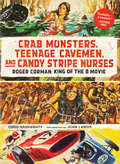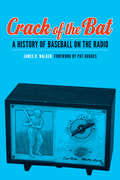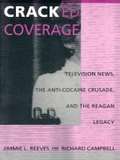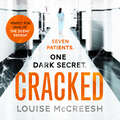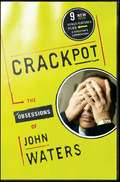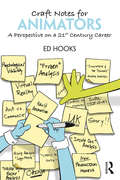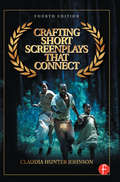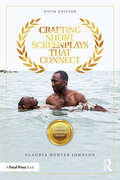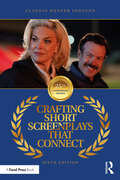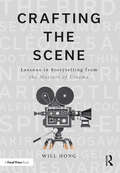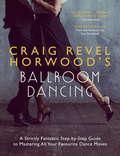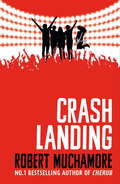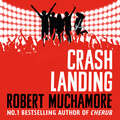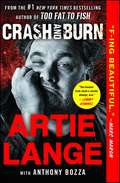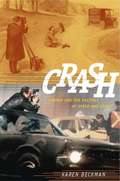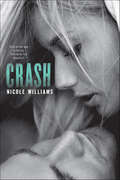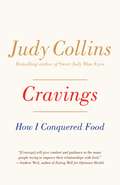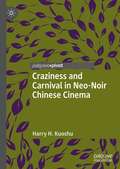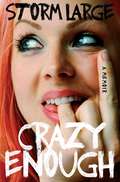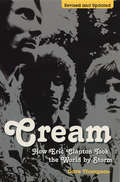- Table View
- List View
Cowboys as Cold Warriors: The Western and U.S. History
by Stanley CorkinThough the United States emerged from World War II with superpower status and quickly entered a period of economic prosperity, the stresses and contradictions of the Cold War nevertheless cast a shadow over American life. The same period marked the heyday of the western film. Cowboys as Cold Warriors shows that this was no coincidence. It examines many of the significant westerns released between 1946 and 1962, analyzing how they responded to and influenced the cultural climate of the country. Author Stanley Corkin discusses a dozen films in detail, connecting them to each other and to numerous others. He considers how these cultural productions both embellished the myth of the American frontier and reflected the era in which they were made. Films discussed include: My Darling Clementine, Red River, Duel in the Sun, Pursued, Fort Apache, Broken Arrow, The Gunfighter, High Noon, Shane, The Searchers, Gunfight at the OK Corral, The Magnificent Seven, The Alamo, Lonely Are the Brave, Ride the High Country, and The Man Who Shot Liberty Valance.
Cowboys, Creatures, and Classics: The Story of Republic Pictures
by Chris Enss Howard KazanjianTake one well-oiled effective killing machine, add a familiar hero on the ground, in the air, and on horseback; stir in a ghastly end that&’s surely impossible to escape, add action, add passion, made on a shoestring budget at breakneck speed, and you&’ve got the recipe for Republic Pictures. Who, after all, cannot forget The Atomic Kid, starring Mickey Rooney, or The Untamed Heiress, with an un-Oscar-worthy performance by ingénue Judy Canova? Exploding onto the movie scene in 1935, Republic Pictures brought the pop culture of the 30s and 40s to neighborhood movie houses. Week after week kids sank into their matinee seats to soak up the Golden Age of the Republic series, to ride off into the classic American West. And they gave us visions of the future. Visions that inspire film makers today. Republic was a studio that dollar for dollar packed more movie onto the screen than the majors could believe. From sunrise on into the night over grueling six day weeks, no matter how much mayhem movie makers were called upon to produce, at Republic Pictures it was all in a day&’s work. Republic Pictures was the little studio in the San Fernando Valley where movies were made family style. A core of technicians, directors, and actors worked hard at their craft as Republic released a staggering total of more than a thousand films through the late 1950s. Republic Pictures was home to John Wayne for thirty-three films. Always inventing, Republic brought a song to the West. It featured the West&’s first singing cowboy. Republic brought action, adventure, and escape to neighborhood movies houses across America. And they brought it with style. Scene from westerns such as The Three Mesquiteers and the Lawless Range gave screaming kids at the bijou a white-knuckle display of expert film making. Republic Pictures became a studio where major directors could bring their personal vision to the screen. Sometimes these were projects no other studio would touch such as The Quiet Man (which brought director John Ford an Oscar) and Macbeth. Killer Bs, Cowboys, Creatures and Classics: The Story of Republic Pictures is for anyone who likes B movies magic. It is the honest account of an extraordinary production house, one whose ability to turn out films quickly boded well for its transition into television production. Not only were its sets used for such shows as Leave it to Beaver and Gilligan&’s Island, stock footage from Republic&’s movies was used on such shows as Gunsmoke and The Life and Legend of Wyatt Earp.
Cozy Gaming
by Liv NganIt's time to put your snuggle top on, cuddle your squishies, and find out all about the cosiest games around! Cosy games include fun, de-stressing, cute and calm games like Stardew Valley, Animal Crossing: New Horizons, Disney Dreamlight Valley, Oxenfree and many more. This book gives you everything you need to focus on diving into the carefree world of cosy gaming, with reviews of the best titles and previews of soon-to-be-released games too. No matter how you game - on consoles, online or on mobile devices - there's something here for you.As well as info on the best games to play, this book is also full of ways to cosy-fy your life-including tips for making your bedroom super snuggly, the cutest squishies and plushies, and the ultimate accessories for all-important self-care. You'll discover how to customise your current room to turn it into a den of relaxation, how to find an aesthetic that works for you, and how to choose your ultimate cosy lifestyle. It's everything you need for your perfect cosy life!
Crab Monsters, Teenage Cavemen, and Candy Stripe Nurses: Roger Corman
by Chris Nashawaty“Delightful . . . an engrossing oral history . . . As an enthusiastic ode to colorful, seat-of-your-pants filmmaking, this one’s hard to beat.” —Booklist (starred review)“Fantastic—a treasure.” —Stephen KingCrab Monsters, Teenage Cavemen, and Candy Stripe Nurses is an outrageously rollicking account of the life and career of Roger Corman—one of the most prolific and successful independent producers, directors, and writers of all time, and self-proclaimed king of the B movie. As told by Corman himself and graduates of “The Corman Film School,” including Peter Bogdanovich, James Cameron, Francis Ford Coppola, Robert De Niro, and Martin Scorsese, this comprehensive oral history takes readers behind the scenes of more than six decades of American cinema, as now-legendary directors and actors candidly unspool recollections of working with Corman, continually one-upping one another with tales of the years before their big breaks.Crab Monsters is supplemented with dozens of full-color reproductions of classic Corman movie posters; behind-the-scenes photographs and ephemera (many taken from Corman’s personal archive); and critical essays on Corman’s most daring films—including The Intruder, Little Shop of Horrors, and The Big Doll House—that make the case for Corman as an artist like no other.“This new coffee table book, brimming with outrageous stills from many of Corman’s hundreds of films, looks at the wild career of the starmaker who was largely responsible for so much of the Hollywood we know today.” —New York Post“Vividly illustrated.” —People“It includes in-depth aesthetic appreciations of ten of Corman’s movies, which, taken together, make a compelling case for Corman as an artist.” —Hollywood.com“Outrageously entertaining.” —Parade“Endlessly fascinating.” —PopMatters
Crack of the Bat: A History of Baseball on the Radio
by Pat Hughes James R. WalkerThe crack of the bat on the radio is ingrained in the American mind as baseball takes center stage each summer. Radio has brought the sounds of baseball into homes for almost one hundred years, helping baseball emerge from the 1919 Black Sox scandal into the glorious World Series of the 1920s. The medium gave fans around the country aural access to the first All-Star Game, Lou Gehrig’s farewell speech, and Bobby Thomson’s “Shot Heard ’Round the World.” Red Barber, Vin Scully, Harry Caray, Ernie Harwell, Bob Uecker, and dozens of other beloved announcers helped cement the love affair between radio and the national pastime. Crack of the Bat takes readers from the 1920s to the present, examining the role of baseball in the development of the radio industry and the complex coevolution of their relationship. James R. Walker provides a balanced, nuanced, and carefully documented look at radio and baseball over the past century, focusing on the interaction between team owners, local and national media, and government and business interests, with extensive coverage of the television and Internet ages, when baseball on the radio had to make critical adjustments to stay viable. Despite cable television’s ubiquity, live video streaming, and social media, radio remains an important medium through which fans engage with their teams. The evolving relationship between baseball and radio intersects with topics as varied as the twenty-year battle among owners to control radio, the development of sports as a valuable media product, and the impact of competing technologies on the broadcast medium. Amid these changes, the familiar sounds of the ball hitting the glove and the satisfying crack of the bat stay the same.
Cracked Coverage: Television News, The Anti-Cocaine Crusade, and the Reagan Legacy
by Richard Campbell Jimmie L. ReevesCarefully documenting the deceptions and excesses of television news coverage of the so-called cocaine epidemic, Cracked Coverage stands as a bold indictment of the backlash politics of the Reagan coalition and its implicit racism, the mercenary outlook of the drug control establishment, and the enterprising reporting of crusading journalism. Blending theoretical and empirical analyses, Jimmie L. Reeves and Richard Campbell explore how TV news not only interprets "reality" in ways that reflect prevailing ideologies, but is in many respects responsible for constructing that reality. Their examination of the complexity of television and its role in American social, cultural, and political conflict is focused specifically on the ways in which American television during the Reagan years helped stage and legitimate the "war on drugs," one of the great moral panics of the postwar era.The authors persuasively argue, for example, that powder cocaine in the early Reagan years was understood and treated very differently on television and by the state than was crack cocaine, which was discovered by the news media in late 1985. In their critical analysis of 270 news stories broadcast between 1981 and 1988, Reeves and Campbell demonstrate a disturbing disparity between the earlier presentation of the middle- and upper-class "white" drug offender, for whom therapeutic recovery was an available option, and the subsequent news treatment of the inner-city "black" drug delinquent, often described as beyond rehabilitation and subject only to intensified strategies of law and order. Enlivened by provocative discussions of Nancy Reagan's antidrug activism, the dramatic death of basketball star Len Bias, and the myth of the crack baby, the book argues that Reagan's war on drugs was at heart a political spectacle that advanced the reactionary agenda of the New and Religious Right--an agenda that dismissed social problems grounded in economic devastation as individual moral problems that could simply be remedied by just saying "no."Wide ranging and authoritative, Cracked Coverage: Television News, the Anti-Cocaine Crusade, and the Reagan Legacy is a truly interdisciplinary work that will attract readers across the humanities and social sciences in addition to students, scholars, journalists, and policy makers interested in the media and drug-related issues.
Cracked: The gripping, dark & unforgettable debut thriller
by Louise McCreeshWhen Jenny's old therapist is murdered and she is implicated, she realizes that someone else out there might know her deepest, darkest secret.Seven patients. One dark secret. Jennifer Nielsen has her life on track. Until she gets news that her former psychiatrist, Phillip Walton, has been brutally murdered, and that she is implicated. Philip knew her darkest secrets. And circumstances of his murder suggest that someone else out there knows them too. Jenny needs to speak to old friends, and old enemies, from her dark years spent at Hillside Psychiatric Hospital. Because they are the only ones who know what really happened at Hillside, about the secret that Phil kept for them all, and that this is not the first murder.(P) 2019 Hodder & Stoughton Ltd
Crackpot: The Obsessions of
by John WatersAn outrageous collection from the uniquely legendary John Waters, updated with new material—including Waters&’s 2002 New York Times article, &“Finally, Footlights on the Fat Girls.&”Crackpot, originally released in 1986, is John Waters&’s brilliantly entertaining litany of odd and fascinating people, places, and things. From Baltimore to Los Angeles, from William Castle to Pia Zadora, from the National Enquirer to Ronald Reagan&’s colon, Waters explores the depths of our culture. And he dispenses useful advice along the way: how not to make a movie, how to become famous (read: infamous), and of course, how to most effectively shock and make our nation&’s public laugh at the same time. Loaded with bonus features, this special edition is guaranteed to leave you totally mental.
Craft Notes for Animators: A Perspective on a 21st Century Career
by Ed HooksIf Disney’s Snow White and the Seven Dwarfs represented the Animation industry’s infancy, Ed Hooks thinks that the current production line of big-budget features is its artistically awkward adolescence. While a well-funded marketing machine can conceal structural flaws, uneven performances and superfluous characters, the importance of crafted storytelling will only grow in importance as animation becomes a broader, more accessible art form. Craft Notes for Animators analyses specific films – including Frozen and Despicable Me – to explain the secrets of creating truthful stories and believable characters. It is an essential primer for the for tomorrow’s industry leaders and animation artists.
Crafting Short Screenplays That Connect
by Claudia H JohnsonCrafting Short Screenplays That Connect, Fourth Edition stands alone among screenwriting books by emphasizing that human connection, though often overlooked, is as essential to writing effective screenplays as conflict. This groundbreaking book will show you how to advance and deepen your screenwriting skills, increasing your ability to write richer, more resonant short screenplays that will connect with your audience. With her candid, conversational style, award-winning writer and director Claudia Hunter Johnson teaches you the all-important basics of dramatic technique and guides you through the challenging craft of writing short screenplays with carefully focused exercises of increasing length and complexity. In completing these exercises and applying Claudia's techniques and insights to your own work, you will learn how to think more deeply about the screenwriter's purpose, craft effective patterns of human change, and strengthen your storytelling skills. This new edition has been expanded and updated to include: A companion website (www.focalpress.com/cw/johnson) with ten award-winning short films featured in the book, including two outstanding, all-new short films--Intercambios and the Student-Emmy-Award-winning Underground A new chapter on scene and structure that will help you find the right structure for your short screenplay A new chapter on crafting effective dialogue and subtext that will teach you to make the most of every word and add further depth to your script
Crafting Short Screenplays That Connect
by Claudia Hunter JohnsonCrafting Short Screenplays That Connect, Fifth Edition, stands alone among screenwriting books by emphasizing that human connection, though often overlooked, is as essential to writing effective screenplays as conflict. This ground-breaking book will show you how to advance and deepen your screenwriting skills, increasing your ability to write richer, more resonant short screenplays that will connect with your audience. Award-winning writer and director Claudia Hunter Johnson teaches you the all-important basics of dramatic technique and guides you through the challenging craft of writing short screenplays with carefully focused exercises of increasing length and complexity. In completing these exercises and applying Johnson’s techniques and insights to your own work, you will learn how to think more deeply about the screenwriter’s purpose, craft effective patterns of human change, and strengthen your storytelling skills. This 20th Anniversary Edition features 11 short screenplays, including Academy Award winning Barry Jenkins' (Moonlight, If Beale Street Could Talk) luminous short film, My Josephine, and an accompanying companion website that features the completed films and additional screenplay examples. The book has also been expanded and updated to include two new award-winning screenplays Killer Kart and The Great Wall of Vicky Lynn. and a brand-new chapter exploring the use of genre in the short film. An absolute must-have resource for students of screenwriting.
Crafting Short Screenplays That Connect
by Claudia Hunter JohnsonCrafting Short Screenplays That Connect, Sixth Edition, stands alone among screenwriting books by emphasizing that human connection, though often overlooked, is as essential to writing effective screenplays as conflict.Award-winning writer and director Claudia Hunter Johnson teaches you the all-important basics of dramatic technique and guides you through the challenging craft of writing short screenplays with carefully focused exercises of increasing length and complexity. In completing these exercises and applying Johnson’s techniques and insights to your own work, you will learn how to think more deeply about the screenwriter’s purpose, craft effective patterns of human change, and strengthen your storytelling skills. This 25th Anniversary Edition features 11 short screenplays, including Academy Award winning Barry Jenkins’ (Moonlight, If Beale Street Could Talk) luminous short film, My Josephine (now in the Criterion Collection), and an accompanying companion website that features the completed films and additional screenplay examples. The book has also been updated and expanded to include more excerpts from leading films and TV series as well as collaboration exercises and invaluable guidance about giving and receiving effective feedback.This ground-breaking book will show you how to advance and deepen your screenwriting skills, increasing your ability to write richer, more resonant short screenplays that will connect with your audience. It remains an absolute must have resource for students of screenwriting.
Crafting the Scene: Lessons in Storytelling from the Masters of Cinema
by Will HongBringing together an understanding of cinematic technique and creative choices, this book explores how directors make the technical choices to tell a story in the best and most effective way. Analyzing examples from films throughout, it demonstrates how to practice analysis and application to take your storytelling to the next level through creative choices. This book provides a model to bridge the gap between theory and practice by analyzing famous scenes and breaking them down not solely for critical value and within historical context, but primarily for practical value and application. Author Hong illustrates how an understanding of dramatic storytelling and the dramatic context behind scenes allows filmmakers to produce impactful and powerful stories. Foregrounding reading film and media to allow you to engage with films in a critical and perceptive way, this book will help you make films to connect with your audience. Through looking at complete scenes as the primary unit of drama, it teaches how to analyze story movement across a scene to build better stories, pulling practical lessons from these famous moments in cinema to enable better work across preproduction, on set, and during post-production. Serving as a guide through a single semester-long class focused on direction and production, this book is aimed at advanced students and aspiring filmmakers. It is essential reading for filmmakers wishing to build on their creative and technical skills and enrich their storytelling.
Craig Revel Horwood's Ballroom Dancing: A guide to mastering the basic steps for absolute beginners
by Craig Revel HorwoodIs this the right book for me?Whether you are an absolute beginner, a Strictly Come Dancing wannabe or simply want a fun way to get fit, Craig Revel Horwood's guide to ballroom dancing offers something for everyone. Learn how to become a ballroom babe or a Latin lover as Craig shows you all the basic moves in a fun, lively and straightforward way. Easy-to-follow instructions and illustrations will help you to learn numerous dances, including the traditional foxtrot, waltz, and tango as well as the more modern mambo, rumba and samba. Each section of dance provides lots of suggestions for great music to strut your stuff to, with helpful tips from Craig to encourage you to practice until you have truly mastered your moves.Learn effortlessly with a new easy-to-read page design and interactive features: Not got much time?One, five and ten-minute introductions to key principles to get you started.Author insightsLots of instant help with common problems and quick tips for success, based on the author's many years of experience.Test yourselfTests in the book and online to keep track of your progress.Extend your knowledgeExtra online articles to give you a richer understanding of the subject.Five things to rememberQuick refreshers to help you remember the key facts.Try thisInnovative exercises illustrate what you've learnt and how to use it.
Craig Revel Horwood's Ballroom Dancing: A guide to mastering the basic steps for absolute beginners (Teach Yourself General Ser.)
by Craig Revel HorwoodIs this the right book for me?Whether you are an absolute beginner, a Strictly Come Dancing wannabe or simply want a fun way to get fit, Craig Revel Horwood's guide to ballroom dancing offers something for everyone. Learn how to become a ballroom babe or a Latin lover as Craig shows you all the basic moves in a fun, lively and straightforward way. Easy-to-follow instructions and illustrations will help you to learn numerous dances, including the traditional foxtrot, waltz, and tango as well as the more modern mambo, rumba and samba. Each section of dance provides lots of suggestions for great music to strut your stuff to, with helpful tips from Craig to encourage you to practice until you have truly mastered your moves.Learn effortlessly with a new easy-to-read page design and interactive features: Not got much time?One, five and ten-minute introductions to key principles to get you started.Author insightsLots of instant help with common problems and quick tips for success, based on the author's many years of experience.Test yourselfTests in the book and online to keep track of your progress.Extend your knowledgeExtra online articles to give you a richer understanding of the subject.Five things to rememberQuick refreshers to help you remember the key facts.Try thisInnovative exercises illustrate what you've learnt and how to use it.
Crash Landing: Book 4 (Rock War #4)
by Robert MuchamoreDon't miss the last episode of international bestseller Robert Muchamore's ROCK WAR series! Jay, Summer and Dylan are fresh out of the biggest reality show there is. But they're about to discover what fame and fortune are really about. Jay's brother Theo is young, rich and famous: but is it making him happy?Summer's got to weather her one-star reviews and take her career back into her own hands.And Dylan might soon be seeing the world of show-business from the four walls of a prison cell. They've got everything to play for. From the author of CHERUB and Henderson's Boys: find out more at rockwar.com
Crash Landing: Book 4 (Rock War #4)
by Robert MuchamoreDon't miss the last episode of international bestseller Robert Muchamore's ROCK WAR series! Jay, Summer and Dylan are fresh out of the biggest reality show there is. But they're about to discover what fame and fortune are really about. Jay's brother Theo is young, rich and famous: but is it making him happy?Summer's got to weather her one-star reviews and take her career back into her own hands.And Dylan might soon be seeing the world of show-business from the four walls of a prison cell. They've got everything to play for. From the author of CHERUB and Henderson's Boys: find out more at rockwar.com(P) 2017 Hodder Children's Books
Crash and Burn
by Artie LangeVeteran comedian Artie Lange turns an unflinching eye and his signature wit on his perilous descent into drug addiction, life-threatening depression, and ultimately, his recovery, in the follow-up to his hilariously raw debut, the #1 New York Times bestseller Too Fat to Fish.At a high point in his career, Artie Lange played a sold-out show in Carnegie Hall and totally killed—yet during his standing ovation, all he could think of were the two bags of heroin in his pocket. In the midst of a deep, self-destructive depression, addicted to heroin and prescription drugs, he lashed out at everyone around him—from his fellow cast members on The Howard Stern Show, to celebrity guests, to his longtime friends, and even his own family. By turns dark and disturbing, hilarious and heartbreaking, and always drop-dead honest, the New York Times bestseller Crash and Burn lifts the curtain on Lange’s dangerous slide. For the first time, Artie reveals all: the full truth behind his now legendary Stern Show meltdown, his suicide attempt (which he relates in terrifying detail), surprising stints in rehab, and painful relapses. With the help and support of friends and family, Artie claws his way back, turning his life and career around. And despite his slip-ups, backslides, and permanent losses, Artie forges on.
Crash: Cinema and the Politics of Speed and Stasis
by Karen BeckmanArtists, writers, and filmmakers from Andy Warhol and J. G. Ballard to Alejandro Gonzlez Irritu and Ousmane Sembne have repeatedly used representations of immobilized and crashed cars to wrestle with the conundrums of modernity. In Crash, Karen Beckman argues that representations of the crash parallel the encounter of film with other media, and that these collisions between media offer useful ways to think about alterity, politics, and desire. Examining the significance of automobile collisions in film genres including the "cinema of attractions," slapstick comedies, and industrial-safety movies, Beckman reveals how the car crash gives visual form to fantasies and anxieties regarding speed and stasis, risk and safety, immunity and contamination, and impermeability and penetration. Her reflections on the crash as the traumatic, uncertain moment of inertia that comes in the wake of speed and confidence challenge the tendency in cinema studies to privilege movement above film's other qualities. Ultimately, Beckman suggests that film studies is a hybrid field that cannot apprehend its object of study without acknowledging the ways that cinema's technology binds it to capitalism's industrial systems and other media, technologies, and disciplines.
Crash: Includes Crash, Clash And Crush (Crash #1)
by Nicole WilliamsIn this first book in the New York Times bestselling Crash trilogy, the world is introduced to this generation's Romeo and Juliet: Jude Ryder and Lucy Larson—Explosive. Sizzling. Tragic.A steamy summer encounter with bad boy Jude means trouble for Lucy. Her sights are set on becoming a ballerina, and she won't let anything get in her way . . . except Jude.He's got a rap sheet, dangerous mood swings, and a fate to ruin the lives of girls like Lucy—and he tells her so.But as rumors run rampant and reputations are destroyed, Lucy's not listening to Jude's warning. Is tragedy waiting in the wings? Or could this be the true love that every romantic dreams of? With red-hot chemistry and shocking twists, this is a love story that is not to be missed.
Cravings: How I Conquered Food
by Judy CollinsA no-holds-barred account of folk legend Judy Collins's harrowing struggle with compulsive overeating and of the journey that led her to a solution. Since childhood Judy Collins has had a tumultuous, fraught relationship with food. Her issues with overeating nearly claimed her career and her life. For decades she thought she simply lacked self-discipline. She tried nearly every diet plan that exists, often turning to alcohol to dull the pain of yet another failed attempt to control her seemingly insatiable cravings. Today, Judy knows she suffers from an addiction to sugar and grains, flour and wheat. She adheres to a strict diet of unprocessed foods consumed in carefully measured portions. This solution has allowed her to maintain a healthy weight for years, to enjoy the glow of good health, and to attain peace of mind. Alternating between chapters on her life and those of the many diet gurus she has encountered along the way (Atkins, Jean Nidetch of Weight Watchers, Andrew Weil, to name a few), Cravings is the culmination of Judy's genuine desire to share what she's learned—so that no one else has navigate her heart-rending path to recovery.
Craziness and Carnival in Neo-Noir Chinese Cinema (Chinese Literature and Culture in the World)
by Harry H. KuoshuCraziness and Carnival in Neo-Noir Chinese Cinema offers an in-depth discussion of the “stone phenomenon” in Chinese film production and cinematic discourses triggered by the extraordinary success of the 2006 low-budget film, Crazy Stone. Surveying the nuanced implications of the film noir genre, Harry Kuoshu argues that global neo noir maintains a mediascape of references, borrowings, and re-workings and explores various social and cultural issues that constitute this Chinese episode of neo noir. Combining literary explorations of carnival, postmodernism, and post-socialism, Kuoshu advocates for neo noir as a cultural phenomenon that connects filmmakers, film critics, and film audiences rather than an industrial genre.
Crazy Enough
by Storm LargeYes, Storm Large is her real name, though she's been called many things. As a performer, the majority of descriptions have led with "Amazon," "Powerhouse," "a six-foot Vargas pinup come to life." Playboy called her a "punk goddess." You'd never know she used to be called "Little S"--the mini-me to her beautiful and troubled mother, Suzi. Storm spent most of her childhood visiting her mother in mental institutions and psych wards. Suzi's diagnosis changed with almost every doctor visit, ranging from schizophrenia to bipolar disorder to multiple personality disorder to depression. As hard as it was not having her at home, Storm and her brothers knew that it was a lot safer to have their beautiful but unreliable mom in a facility somewhere. Then one day, nine-year-old Storm jokingly asked one of her mother's doctors, "I'm not going to be crazy like that, right?" To which he replied, "Well, yes. It's hereditary. You absolutely will end up like your mother. But not until your twenties." That was the starting gun for a wild race to escape what Storm believed to be her future. Desperate to delay the lonely sickness and sadness that haunted her mother, Storm stomped her size-twelve boots straight toward as much sex, drugs, and rock 'n' roll as she could find. Losing her virginity at thirteen, she sprinted through her young life, trying to smoke and fuck and wail away the madness that she feared would catch up to her at any moment. Instead, she found herself deep in a life of craziness of her own making. Then, in her twenties, with nothing to live for and a growing heroin addiction, Storm accepted a chance invitation to sing with a friend's band. That night she reconnected with her long-term love of music, and it dragged her back from the edge. She has been singing and slinging inappropriate banter at audiences worldwide ever since. Storm's story of growing up with a mental time bomb hanging around her neck veers from frightening to inspiring, sometimes all in one sentence. But her strength, charisma, and raw musical talent gave her the will to overcome it all. With tremendous honesty and tremendous dirty language, Crazy Enough is about an artist's journey of realizing that the mistakes that make, break, and remake us are worth far more than our flailing attempts to live a life we think is "normal." It is a love song to the twisted, flawed parts in all of us and a nod to the grace we find when things fall apart.
Crazy Enough: A Memoir
by Storm LargeYes, Storm Large is her real name, though she's been called many things. As a performer, the majority of descriptions have led with "Amazon," "powerhouse," "a six-foot Vargas pinup come to life." Playboy called her a "punk goddess." You'd never know she used to be called "Little S"--the mini-me to her beautiful and troubled mother, Suzi. Little S spent most of her childhood visiting her mother in mental institutions and psych wards. Suzi's diagnosis changed with almost every doctor's visit, ranging from schizophrenia to bipolar disorder to multiple personality disorder to depression. One day, nine-year-old Little S jokingly asked one of her mother's doctors, "I'm not going to be crazy like that, right?" To which he replied, "Well, yes. It's hereditary. You absolutely will end up like your mother. But not until your twenties." Storm's story of growing up with a mental time bomb hanging over her veers from frightening to inspiring, sometimes all in one sentence. But her strength, charisma, and raw musical talent gave her the will to overcome it all. Crazy Enough is a love song to the twisted, flawed parts in all of us.
Cream: How Eric Clapton Took the World by Storm
by Dave ThompsonDave Thompson, author of Virgin's acclaimed Red Hot Chili Peppers biography, takes a new and very detailed look at the creation of one of the world's most influential bands. After all the streets of London had been covered in 'Clapton Is God' tributes, the three top rock instrumentalists of their time, all stars in their own right, came together to form Cream. Cream went on to become the first band to break openthe lucrative US market by dint of their live shows alone. Updated to include details of their recent tour, this definitive account goes on the road with them then and now, day by relentlessly hedonistic day.
